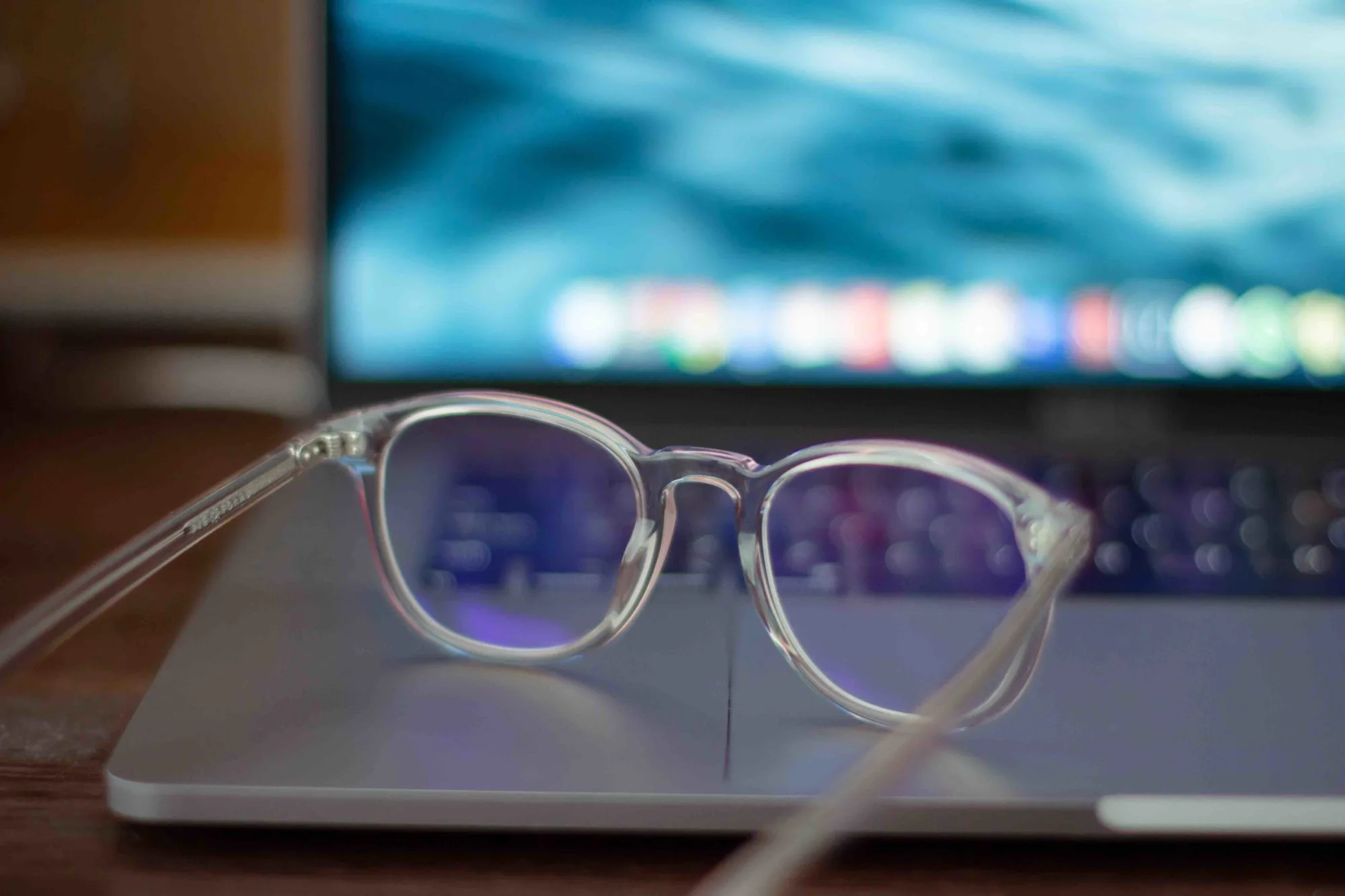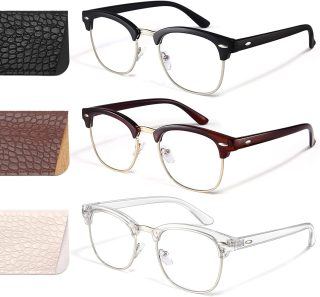We live in the digital age, where we are constantly on our digital devices. From cell phones and laptops to tablets and computers, these devices have become a crucial part of our everyday lives. However, this is taking a toll on our physical health, more specifically, our eye health.
These screens may seem harmless, but with the average person’s screen time being 6 hours and 58 minutes a day, we’re exposing our eyes to prolonged blue light, which can be fairly harmful.
What is Blue Light?
Blue Light is a high-energy spectrum of light that is part of the electromagnetic spectrum, also known as visible light. Emitted by the sun and man-made sources such as cellphones, and laptops, blue light has the shortest wavelength, which makes it very concentrated and high in energy.
Blue light is essential for us due to its impact on our circadian rhythm. Higher exposure to blue light, which we experience in the daytime, tells our body we should be awake. On the other hand, lower exposure, which we experience in the evening, tells our body we should be resting, thus helping to regulate our sleep and wake cycle. By supplementing natural blue light with that from digital devices, we are confusing our bodies and deprogramming our usual wake and sleep patterns.
However, blue light isn’t just disrupting our circadian rhythm, but also impacting our eye health. Raising concerns for many physicians, blue light can reach deep into the eyes, thus causing eye fatigue.
Eye Fatigue
If you’ve felt a nagging pain behind your eye after staring at your devices the whole day, you are experiencing eye fatigue. Eye fatigue manifests itself in the form of achy, tired, itchy, burning, dry, or watery eyes.
Studies show that people of all ages blink far less often when concentrating on a screen, which in turn causes the eyes to dry out. A clear and stable tear film on the eye surface is essential for clear vision, and eye fatigue disrupts this. The symptoms caused by eye fatigue can also be linked to Computer Vision Syndrome.
Computer Vision Syndrome
Affecting between 64-90% of all office workers, Computer Vision Syndrome (CVS) is a condition in which you experience one or more eye symptoms as a result of prolonged working on a digital device.
When you work on a computer, your eye muscles are constantly working by having to focus on text or images, moving back and forth, with you having to look down at papers, then up again to type. All these jobs can cause a lot of strain on your eye muscles.
A Malaysian study surveyed 795 Malaysian college students aged 18 to 25 years regarding the duration of daily continuous use of digital devices, and symptoms of CVS.
The results of the study showed the prevalence of symptoms of CVS (one or more) to be 89.9%, with the most disturbing symptom being headaches (19.7%). Students who used computers for more than 2 hours per day experienced significantly more symptoms of CVS, including blurred vision, neck pain, eye irritation (dry, itchy, red eyes), and backaches.
CVS and Nearsightedness
Research has found a link between the excessive use of digital devices and nearsightedness, a vision condition which affects about 30-40% of adults in the U.S. Also known as Myopia, this condition is explained as a reflective error that makes far-away objects look blurry, while nearby objects are clear, due to the shape of the eye making light focus in front of the retina instead of on it.
The retina is a light sensitive layer of tissue behind your eye which converts light that enters the eye into electronic signals that the brain can process into an image.
Myopia usually starts between the ages of 6 and 14, worsening until your early twenties. This shows how eye care needs to be prioritized at a young age when the eyes are still developing.
One of the most common solutions to prevent the onset of this condition, amongst other eye conditions, is known as the 20-20-20 rule, which physicians advise we use to maintain eye health.
The 20-20-20 Rule
The rule says that for every 20 minutes spent looking at a screen, you take a 20-second break and look at something 20 feet away, which relaxes the muscles for 20 seconds, giving your brain and eyes a much-needed break.
It may be a bit difficult to measure exactly how far 20 feet is, so just look at the building across the street, or a tree that isn’t too far away that your eye muscles need to work to focus on the distant object.
Why 20 Seconds?
It takes 20 seconds for your eyes to relax, which is the whole premise of the rule. It is advised that while you’re taking a break, you hydrate. Drinking a cup of green tea may be extremely helpful due to it containing catechins, an antioxidant that has been shown to help your eyes produce tears to ensure better lubrication for them.
What Else Can I Do?
Positioning Your Device
Wesley Language, head of optometry at Spec-Savers, advises that we minimize eye strain by using a 1-2-10 rule when it comes to screen positioning. “Hold phones one foot (30 centimeters) away; sit two feet (60 centimeters) away from laptops and desktops; and encourage children to sit 10 feet (three meters) away from the television.”
Reducing Glare
Ophthalmologist and retina specialist Rishi P. Singh, M.D., advises that we reduce glare from our digital devices, advising that you “position your screen to avoid glare from overhead lights or windows.” A reflection on your device forces your eyes to work harder, therefore straining the muscles.
Blue-Light Glasses
These glasses are designed to block or filter out blue light. Some studies have shown that they help:
- Improve sleep quality due to limited blue light exposure
- Alleviate eye fatigue
- Improve your visual performance
While these may not be effective for everyone, they have been shown to be effective in reducing potential eye damage from prolonged blue light exposure. Available options include:
Amazon Essentials Unisex Bluelight and UV400 blocking Glasses
Racico Computer Blue Light Blocking Glasses
Blue Light Contact Lenses
If you’re not a fan of glasses, you’re in luck, as you can now get blue light contact lenses. Last year, Johnson & Johnson announced the launch of Acuvue Oasys Max 1-Day contact lenses, which they say have the ability to “filter out 60% of blue-violet light,” making this more convenient.
Preventing It From The Inside
According to optometrist Jeff Anshel, O.D., FAAO, “the best protection (from blue light) is to consume lutein and zeaxanthin.” These carotenoids are responsible for neutralizing free radicals and filtering blue light, acting as “internal sunglasses”, which help protect our eyes from the inside out.
Our bodies do not make these carotenoids on their own, but we can obtain them through our diet. Foods high in these carotenoids include:
- Dark Leafy Greens
- Broccoli
- Carrots
- Pistachios
- Peas
- Pumpkin
- Summer squash
Alternatively, you can take a supplement, such as the following vegan-friendly options:
Sports Research Vegan Lutein + Zeaxanthin
Doctor’s Best Lutein with OptiLut
Eye Health Needs to Be Prioritized
It’s very easy to get caught up in a fast-paced world and forget that our eyes need just as much attention as the rest of our bodies. If left untreated, CVS can cause health and vision-related problems, such as farsightedness and severe headaches.
So whether it’s decreasing your screen time, implementing the 20-20-20 rule, or getting a pair of blue-light glasses, we need to ensure that we look after our eyes. After all, aren’t they the windows to the soul?
References
- Ouyang, X.I.N.L.I., Yang, J., Hong, Z., Wu, Y., Xie, Y. and Wang, G., 2020. Mechanisms of blue light-induced eye hazard and protective measures: a review. Biomedicine & Pharmacotherapy, 130, p.110577.
- Nwachukwu, I.D., Udenigwe, C.C. and Aluko, R.E., 2016. Lutein and zeaxanthin: Production technology, bioavailability, mechanisms of action, visual function, and health claim status. Trends in Food Science & Technology, 49, pp.74-84.







![women [longevity live]](https://longevitylive.com/wp-content/uploads/2020/01/photo-of-women-walking-down-the-street-1116984-100x100.jpg)










